FIG PUBLICATION NO. 45
Land Governance in Support of
The Millennium Development Goals
A New Agenda for Land Professionals
FIG / World Bank Conference
Washington DC, USA 9–10 March 2009
Stig Enemark
Robin McLaren
Paul van der Molen
Contents
1. Foreword
2. Executive Summary
Global Challenges
Land Governance Supporting the Global Agenda
The Conference
Conclusions
3. Declaration
4. Conference Profile
Setting the Scene
5. Land Governance
Supporting the Millennium Development Goals (MDGs)
Responding to the New Challenges
6. Conference Highlights and the Way Forward
Theme 1: Land Governance for the 21st Century
Highlights of the Conference
The Way Forward
Theme 2: Building Sustainable and Well Governed Land
Administration Systems
Highlights of the Conference
The Way Forward
Theme 3: Securing Social Tenure for the Poorest
Highlights of the Conference
The Way Forward
Theme 4: Making Land Markets Work for All
Highlights of the Conference
The Way Forward
Theme 5: Improving Access to Land and Shelter
Highlights of the Conference
The Way Forward
Theme 6: Land Governance for Rapid Urbanisation
Highlights of the Conference
The Way Forward
7. Appendices
Conference Programme
Reference to Proceedings
Orders for printed copies
1. Foreword
This publication is a result of the joint FIG-World Bank
Conference on “Land Governance in Support of the Millennium Development
Goals: Responding to New Challenges” held at the World Bank Headquarters
in Washington DC, 9–10 March 2009. It includes a report identifying the
highlights of the conference, the ways forward, and also a declaration
produced as a conclusion of the conference.
The organisers wish to thank all who participated, contributed,
supported and encouraged this conference. The support and funding providing by
the ESRI, Trimble, The Dutch Kadastre, GTZ, Leica, and ITC are gratefully
acknowledged. Finally, we wish to convey our sincere gratitude and thanks to all
the delegates who travelled from all parts of the world to attend this
conference and participated so actively and enthusiastically.
This report will be tabled at the FIG Congress in Sydney 11–16
April 2010 and at the World Bank Land Conference in Washington 26–27 April 2010.
This should assist national governments and land professionals to develop and
improve appropriate land governance in support of the Millennium Development
Goals and to address the new challenges.
Stig Enemark
FIG President |
Klaus Deininger
Lead Economist, World Bank |

World Bank Headquarters, Washington D.C., USA
2. Executive Summary
The 21st century has dawned with the world facing global issues of climate
change, critical food and fuels shortages, environmental degradation and natural
disaster related challenges as today’s world population of 6.8 billion continues
to grow to an estimated 9 billion by 2040 when over 60% will be urbanised. This
is placing excessive pressure on the world’s natural resources.
The eight Millennium Development Goals (MDGs) form a blueprint agreed to by
all the world’s countries and the world’s leading development institutions to
support the mitigation of these global issues. The first seven goals are
mutually reinforcing and are directed at reducing poverty in all its forms. The
last goal – global partnership for development – is about the means to achieve
the first seven. These goals are now placed at the heart of the global agenda.
Land Governance Supporting the Global Agenda
Land governance is about the policies, processes and institutions by which
land, property and natural resources are managed. This includes decisions on
access to land, land rights, land use, and land development. Land governance is
basically about determining and implementing sustainable land policies and
establishing a strong relationship between people and land. Sound land
governance is fundamental in achieving sustainable development and poverty
reduction and therefore a key component in supporting the global agenda, set by
adoption of the MDGs. The contribution of the global community of Land
Professionals is vital.
Measures for adaptation to climate change will need to be integrated into
strategies for poverty reduction to ensure sustainable development. The land
management perspective and the role of the operational component of land
administration systems therefore need high-level political support and
recognition.
The conference involved 200 invited international experts and was jointly
organised by FIG and the World Bank with the overall objective to emphasise the
important role of Land Governance in implementing the Millennium Development
Goals (MDGs) and responding to new global challenges. The responses are
categorised into the following six conference themes:
The Land Governance for the 21st Century theme focused on adapting and
improving our approaches to land governance to be more sensitive to and
supportive of these new challenges and to make stakeholders fully aware of the
incentives to adopt this paradigm shift. Good land governance must not only
control and manage the effective use of physical space, but must also be
holistic to ensure sound economic and social outcomes. The World Bank’s land
governance assessment framework provides countries with an opportunity to assess
and improve their current approaches to meet these global challenges, especially
climate change. Land governance must be further democratised by developing tools
for all stakeholders to increasingly participate and form partnerships in policy
formulation, implementation and monitoring all within more realistic timeframes.
The international community must also provide guidance and contract evaluation
tools and services to mitigate the risks for countries negotiating international
land acquisition contracts – the so called ‘farmlands grab.’
The Building Sustainable, Well Governed Land Administration Systems (LAS)
theme emphasised the role of LAS in providing the infrastructure for
implementing land policies and land management strategies in support of
sustainable development. LAS must evolve and must be aligned with the current
needs of a country through the requirements defined in a land policy framework.
LAS are most effective when managed as a business and have a sustainable funding
model based on a robust business case. Early investments in positioning
infrastructures can realise significant benefits in a wide range of land
applications. However, it is estimated that LAS are only fully operational and
work reasonably well in about 30 and mainly western countries. Thus, the
fundamental support of LAS in achieving the MDGs is of serious concern.
The Securing Social Tenure for the Poorest theme addressed the need of
securing tenure for the rural poor and the 1 billion slum dwellers world-wide;
reaching 1.4 billion by 2020 if no remedial action is taken. Conventional
cadastral and land registration systems cannot supply security of tenure to the
vast majority of the low income groups. It is imperative that we develop
innovative new approaches that can be scaled to solve this escalating global
issue. It is essential to establish good land policies that achieve equitable
land distribution and fair laws that are pro-poor. However, new pro-poor,
scalable tools to achieve security of tenure for the slum dwellers need to
include social and customary tenure approaches and the corresponding LAS should
adopt the Social Tenure Domain Model that is currently being developed in a
cooperation between FIG, ITC, UN-HABITAT and the World Bank.
The Making Land Markets Work for All theme identified ways of breaking
down the barriers to land markets access. In many countries certain land rights
are not a tradable commodity, such as customary land rights, allodial lands,
religious lands etc., and access to the market may be restricted by financial,
corruption, social or informational reasons. The sub-prime mortgage crisis and
the unbundling of property rights into complex commodities have also exposed
high risk groups and in many cases poor people have been left landless. Fairer
and more equitable access to the land sales and rental markets can be achieved
through an effective primary land market, the provision of homeowners guarantee
funds, government co-ordination of social housing, market transparency to reduce
corruption and the introduction of monitoring tools to evaluate the performance
of the functioning of land markets, e.g. the World Bank ‘Doing Business Reports.
The Improving Access to Land and Shelter theme focussed on
interventions to support the increasing number of citizens who do not have
access to land and adequate shelter. This exclusion is caused, in many cases, by
structural social inequalities, inheritance constraints, conflicts, and often
land administrations systems are ineffective and expensive for the end user.
Land reform is unfinished business and interventions are still necessary to
reduce the structural inequalities since market forces will not naturally
alleviate the situation. The forced migration of people in conflict situations,
or the result of disasters, causes significant access issues to land and
shelter. Longer term measures for housing and land and property rights need to
be put in place to support social stability. Finally, more effective gender
responsive land tools are required to widen women’s access to land. All these
interventions need to be applied within the broader context of economic growth
and poverty reduction policies.
The Land governance for Rapid Urbanisation theme reviewed responses to
this global phenomenon that will result in 60% of the world’s population being
urbanised by 2030. This incredibly rapid growth causes severe ecological,
economical and social problems, with over 70% of the growth in developing
countries currently happens outside of the formal planning process. However,
urbanisation with the continuing concentration of economic activities in cities
is inevitable and generally desirable. Increasing economic density remains the
objective for all areas at different stages of urbanisation. Due to the
significant dynamics of urbanisation, urban planning and public infrastructure
provision tends to be reactive rather than a guide to development. It is
therefore essential that appropriate priorities for policies are set at
different stages in urbanisation, essentially providing the elements of an
urbanisation strategy that conforms to the reality of growth and development.
Effective and democratised land governance is at the heart of delivering the
global vision of our future laid out in the MDGs. However, the route to this
vision is rapidly changing as a series of new environmental, economic and social
challenges pervade and impact every aspect of our lives. Land Professionals have
a vital role to play and we must understand and respond quickly to this on-going
change. Our approaches and solutions across all facets of land governance and
associated Land Administration Systems must be continually reviewed and adapted
so that we can better manage and mitigate the negative consequences of change.
Central to this is our response to climate change and food security.
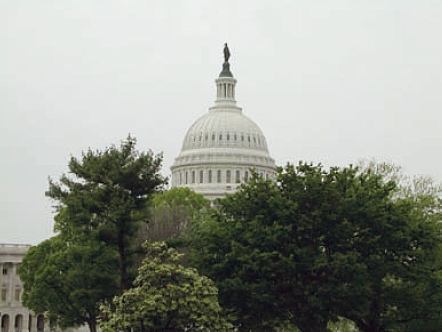
Washington D. C., USA.
3. Declaration
FIG–World Bank Declaration on Land Governance in Support
of the Millennium Development Goals
All countries have to deal with governing their land. They have to
deal with the governance of land tenure, land value, land use and land
development in some way or another. A country’s capacity may be advanced
and combine all the activities in one conceptual framework supported by
sophisticated ICT models or, more likely, capacity will be involved in
very fragmented and basically analogue approaches.
Effective systems for recording various kind of land tenure,
assessing land values and controlling the use of land are the foundation
of efficient land markets and sustainable and productive management of
land resources. Such systems should be based on an overall land policy
framework and supported by comprehensive land information and
positioning infrastructures.
Sustainable land governance should:
- Provide transparent and easy access to land for all and
thereby reduce poverty;
- Secure investments in land and property development and
thereby facilitate economic growth;
- Avoid land grabbing and the attached social and economic
consequences;
- Safeguard the environment, cultural heritage and the use
natural resources;
- Guarantee good, transparent, affordable and gender
responsive governance of land for the benefit of all including the
most vulnerable groups;
- Apply a land policy that is integrated into social and
economic development policy frameworks;
- Address the challenges of climate change and related
consequences of natural disasters, food shortage, etc.; and
- Recognise the trend of rapid urbanisation as a major
challenge to sustain future living and livelihoods.
As an outcome of the conference, some key recommendations have
emerged. These are argued in more details in this report in terms of the
way forward within the six themes of the conference. |
4. Conference Profile
The conference was jointly organised by FIG and the World Bank with the
overall objective to emphasise the important role of Land Governance in
implementing the Millennium Development Goals (MDGs) and responding to new
challenges such as Climate Change and Urban Growth. The conference
demonstrated how FIG and the World Bank are working in parallel to achieve
these global aims.
The conference aimed to illustrate the far reaching impact of land
institutions, highlighting successes, failures and remaining challenges for
improving land, and identify resources and measures that can be drawn upon
by interested parties.
The conference was recognised as a major milestone in tackling global
land issues and was attended by around 200 invited internationals experts
within the land sector representing governments, UN agencies, development
agencies, professionals, academia and the private sector.
The conference was divided into six themes:
- Land Governance for the 21st century;
- Building sustainable, well governed land administration systems;
- Securing social tenure for the poorest;
- Making land markets work for all;
- Improving access to land and shelter; and
- Land governance for rapid urbanisation.
About 80 papers were presented in 20 sessions. Proceedings are available
on both the FIG and the World Bank websites and the full programme of the
conference is presented in Appendix 1.
- The President of Liberia, live in a video-conference with
the opening session, described the rebuilding of Land
Administration institutions to provide access to land as
essential to rekindle economic growth and social stability
following the 25 years of war that tore her country apart. Her
one request to the conference was to be “quick in solving her
land issues”.
- India has embarked on converting their deeds based land
registration system for rural areas into a title based one. This
is a daunting task involving over 140 million owners and 430
million records in nine scripts and 18 languages. However, it is
estimated that it will result in an uplift of 1.3% GDP and
reduce petty corruption in the land sector by around US$700
million/year (more than India’s entire science and technology
budget). [R. Sinha]
- A similar process is unfolding in Indonesia where it is
estimated that 7.3 million hectares of land currently lies idle
or abandoned with a significant direct opportunity loss each
year. The process is being accelerated by using mobile land
offices in rural areas – including motorcycles. [J. Winoto]
|
5. Land Governance
Arguably sound land governance is a key to achieve sustainable
development and to support the global agenda as set by adoption of the
Millennium Development Goals (MDGs). Land governance is about the policies,
processes and institutions by which land, property and natural resources are
managed. This includes decisions on access to land, land rights, land use,
and land development. Land governance is basically about determining and
implementing sustainable land policies.
Sound land management requires operational processes to implement land
policies in comprehensive and sustainable ways. Many countries, however,
tend to separate land tenure rights from land use opportunities, undermining
their capacity to link planning and land use controls with land values and
the operation of the land market. These problems are often compounded by
poor administrative and management procedures that fail to deliver required
services. Investment in new technology will only go a small way towards
solving a much deeper problem: the failure to treat land and its resources
as a coherent whole. Such a global perspective for land governance and
management is shown below (Enemark).
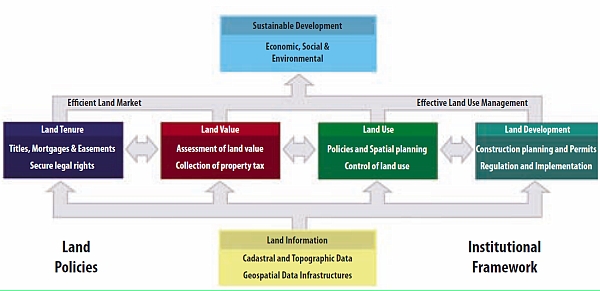
A Global Land Management Perspective.
Land governance and management covers all activities associated with the
management of land and natural resources that are required to fulfil
political and social objectives and achieve sustainable development. This
relates specifically to the legal and institutional framework for the land
sector. The operational component of the land management concept is the
range of land administration functions that include the areas of: land
tenure (securing and transferring rights in land and natural resources);
land value (valuation and taxation of land and properties); land use
(planning and control of the use of land and natural resources); and land
development (implementing utilities, infrastructure, construction planning,
and schemes for renewal and change of existing land use). All of these are
essential to ensure control and management of physical space and the
economic and social outcomes emerging from it.
Land Administration Systems (LAS) are the basis for conceptualising
rights, restrictions and responsibilities. Property rights are normally
concerned with ownership and tenure whereas restrictions usually control use
and activities on land. Responsibilities relate more to a social, ethical
commitment or attitude to environmental sustainability and good husbandry.
In more generic terms, land administration is about managing the relations
between people, policies and places in support of sustainability and the
global agenda set by the MDGs.
Good governance is generally recognised as critical for sustainable
growth and poverty reduction. At the same time, the impact of the legal and
institutional frameworks that determine how land related issues are managed
has only recently been fully appreciated.
Supporting the Millennium
Development Goals (MDGs)
The eight MDGs form a blueprint agreed to by all the world’s countries
and the world’s leading development institutions. The first seven goals are
mutually reinforcing and are directed at reducing poverty in all its forms.
The last goal – global partnership for development – is about the means of
achieving the first seven.
These goals, as shown in figure below, are now placed at the heart of the
global agenda. To track the progress in achieving the MDGs a framework of
targets and indicators has been developed. This framework includes 18
targets and 48 indicators enabling the ongoing monitoring of the progress
that is reported on annually.
Goal 1: Eradicate extreme poverty and hunger
Goal 2: Achieve universal primary education
Goal 3: Promote gender equality and empower women
Goal 4: Reduce child mortality
Goal 5: Improve maternal health
Goal 6: Combat HIV/AIDS, malaria and other diseases
Goal 7: Ensure environmental sustainability
Goal 8: Develop a Global Partnership for Development |
The Eight Millennium Development Goals.
The MDGs represent a wider concept or a vision for the future, where
proper land governance is central and vital and where the contribution of
the global community of land professionals is fundamental. This relates to
the areas of providing the relevant geographic information in terms of
mapping and databases of the built and natural environment, and also
providing secure tenure systems, systems for land valuation, land use
management and land development. These aspects are all key components in
achieving the MDGs.
Responding to the New Challenges
The key challenges of the new millennium are clearly listed already. They
relate to climate change; food shortage; urban growth; environmental
degradation; and natural disasters. These issues all relate to governance
and management of land.
The challenges of food shortage, environmental degradation and natural
disasters are to a large extent caused by the overarching challenge of
climate change, while the rapid urbanisation is a general trend that in
itself has a significant impact on climate change. Measures for adaptation
to climate change must be integrated into strategies for poverty reduction
to ensure sustainable development and for meeting the MDGs.
The UN secretary general Ban Ki-moon has stated that “climate change is
the defining challenge of our time”. He said that ”combining the impacts of
climate change with the current global financial crisis we risk that all the
efforts that have been made by countries to meet the Millennium Development
Goals and to alleviate poverty, hunger and ill health will be rolled back.
It is clear that those who suffer the most from the increasing signs of
climate change are the poor. Those that contributed the least to this
planetary problem continue to be disproportionately at risk.”
On the other hand the global challenge of climate change also provides a
range of opportunities. The Executive Director of UN-Habitat Dr. Anna
Tibaijuka has said (Urban World, March 2009) that “prevention of climate
change can be greatly enhanced through better land–use planning and building
codes so that cities keep their ecological footprint to the minimum and make
sure that their residents, especially the poorest, are protected as best as
possible against disaster”. This also relates to the fact that some 40
percent of the world´s population lives less than 100 km from the coast
mostly in big towns and cities. A further 100 million people live less than
one metre above mean sea level.
The Director General of UN-FAO, Jacques Diouf, has said (World Summit of
Food Security, November 2009) that “in support to climate change mitigation
and adaptation policy, the FAO created a National Forest Programme Facility
in 2002’”. The initiative is presently supporting 70 countries and regional
organisations. In 2008 FAO established the United Nations Collaborative
Programme on Reducing Emissions from Deforestation and Forest Degradation in
Developing Countries followed by a global forest monitoring system in
support of carbon accounting and payments.
Adaptation to and mitigation of climate change, by their very nature,
challenge governments and professionals in the fields of land use, land
management, land reform, land tenure and land administration to incorporate
climate change issues into their land policies, land policy instruments and
facilitating land tools. More generally, sustainable land administration
systems should serve as a basis for climate change adaptation and
mitigation. The management of natural disasters resulting from climate
change can also be enhanced through the creation and maintenance of
appropriate land administration systems. Climate change increases the risks
of climate-related disasters, which cause the loss of lives and livelihoods,
and weaken the resilience of vulnerable ecosystems and societies.
In short, the linkage between climate change adaptation and sustainable
development should be self evident. Measures for adaptation to climate
change will need to be integrated into strategies for poverty reduction to
ensure sustainable development. The land management perspective and the role
of the operational component of land administration systems therefore need
high-level political support and recognition.
6. Conference Highlights and the Way
Forward
Theme 1: Land Governance for the
21st Century
At the start of the 21st century the world is facing critical global food
and fuels shortages, climate change, urban growth, environmental degradation
and natural disaster related challenges as today’s world population of 6.8
billion continues to grow to an estimated 9 billion by 2040. This is placing
inordinate pressure on the world’s natural resources.
The surge in the price of key food products such as rice and wheat, which
last year hit record highs, sparked food riots in many countries. Food
security has become a key global challenge. In response to the crisis, many
countries and private corporations are exploring new ways of safeguarding
their supplies of natural resources; especially crops for food and
bio-fuels. A global search is now underway to identify ‘underutilised’ land
in areas suitable for agricultural production and to acquire the land for
large scale agricultural production. Significant areas of land in Africa,
India and South America have now been bought or leased to foreign countries
or corporations – the so called ‘farmlands grab.’
Although these investments attract capital along with technology and
market knowledge to potentially improve agriculture, there are many inherent
concerns that are not always covered in the associated contracts:
agricultural produce is directly exported from countries with a food
deficit; there is no ‘unused’ land and in many cases local people are taken
off the land with little compensation; the easiest land to acquire is
government land and the benefits normally go to the political elite rather
than the local people; large scale agriculture does not employ significant
numbers of local people; and much common land, such as grazing land, is
targeted and lost. It is increasingly relevant that we strengthen land
governance across the globe to ensure that all stakeholders understand their
roles and responsibilities in managing land, property and natural resources
within a sustainable and equitable framework.
The key challenges of the new millennium are all interconnected, with
many being perpetrated by climate change. Our understanding of the problems
and the formulation of potential solutions will only be achieved through a
holistic approach involving collaboration across the professions. Land
professionals have a key role in this alliance through the effective
management of spatial information related to the built and natural
environments and the application of good land governance to help mitigate
the damaging impacts on our world and society. We need to adapt our
approaches to be more sensitive to and supportive of these new challenges
and make stakeholders fully aware of the incentives for adopting this
paradigm shift. Good land governance must not only control and manage the
effective use of physical space, but must also ensure sound economic and
social outcomes.
Highlights of the Conference
- The World Bank has sponsored a project to develop and test a general
framework for assessing land governance. This is based on the Public
Expenditure and Financial Accountability methodology and involves five
themes, 24 indicators and 80 dimensions and is currently being tested in
pilot projects in Indonesia, Kyrgyzstan, Peru and Tanzania. This
assessment framework should be adopted by countries to assess and
improve their current approaches to Land Governance.
[T. Burns]. This work is complemented by the recently launched UN-FAO
initiative to produce Voluntary Guidelines on Responsible Governance of
Tenure of Land an activity being sponsored by RICS and FIG [M.
Torhonen].
- Many countries are strengthening their land governance arrangements
and reports were provided by Tanzania [L. Kironde], Peru [V. Endo] and
Kyrgiz Republic [A. Endeland] where they highlighted an urgent need to
improve governance in the land sector to ensure economic sustainability,
poverty alleviation and peace and security. Advances have been made in
land policies, recognition of a continuum of rights, communal rights,
the rights for women, stakeholder involvement in developing land
policies and laws, improved planning solutions and land based taxation.
However, most countries still have problems in the institutional
arrangements and capacity to deliver effective land governance.
- Large scale, international land acquisitions are increasing,
especially in Africa, driven by food security and the scramble for
biofuels [D. Byerlee]. There are issues around the export of
agricultural produce directly from countries with a food deficit, the
fact that there is no ‘unused land’ and significant loss of ‘commons’ to
local people.
- A proposal was made to engage communities as key stakeholders in
climate change and poverty mitigation by extending the bundle of rights
associated with land to include key natural resources and the rights to
carbon [G. Barnes].
- The Land Reporting Initiative, organised by the International Land
Coalition monitors land issues and trends and seeks to facilitate
collaboration between civil society and inter-governmental organisations
to promote better monitoring of land issues for ensuring impact on
poverty reduction [A. Mauro].
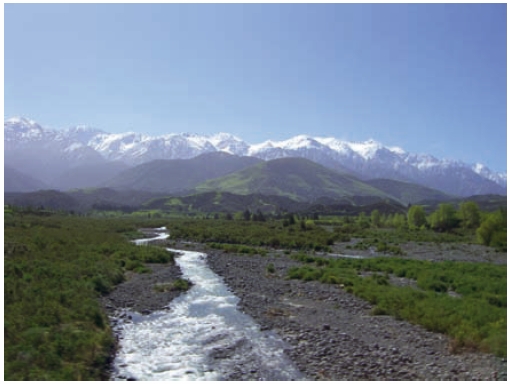
New Zealand.
1. Adapt land governance to be more supportive of our global challenges
Effective and democratised land governance is at the heart of delivering
the global vision of our future laid out in the MDGs. However, the route to
this vision is changing as a series of new environmental, economic and
social challenges spread through and impacts every aspect of our lives. The
degree of change and uncertainty in our world is increasing. As land
professionals we must understand and respond quickly to this on-going
change. Our approaches and solutions across all facets of land governance
must be reviewed and adapted so that we can better manage and mitigate the
negative consequences of change. Central to this is our response to climate
change.
2. Adopt the world bank assessment framework to improve current
approaches to land governance
Poor land governance has far-reaching economic and social consequences:
lack of inward investment and economic growth; limited poverty reduction;
increased deep-rooted conflicts; significant corruption and land grabbing.
This all leads to social instability. The increase in population and the
growing demand for land driven by food security and biofuels needs will
increase the value of land. These trends will worsen the current land
related problems unless land governance can be improved to cope with these
new challenges. The World Bank’s land governance assessment framework
provides countries with an opportunity to assess and improve their current
approaches to land governance. This should be an on-going process and
countries should transparently publish their assessment results in the
public domain. The assessment framework should also be regularly updated to
ensure that the land governance we aspire to is increasingly relevant to the
new millennium, global challenges, especially climate change.
3. Increase participatory tools to build partnerships and further
democratise land governance
As the visibility and role of land governance strengthens in the wider
policy arena, it is essential that we further democratise land governance by
developing tools for all stakeholders to increasingly participate and form
partnerships in policy formulation, implementation and monitoring. For
example, land policy reforms contribute more fully to poverty reduction and
sustainable development when closely related to processes that empower civil
society, especially poor men and women, in decision-making processes. And
more effective aid is provided when development partners are involved early
in planning policy implementation. These tools need to be shared across the
international community. However, secure land rights are fundamental in
minimising arbitrary dispossession and maximising local benefit.
4. Provide contract evaluation tools to safeguard nations from
inappropriate large scale, international land acquisitions
The ethical basis and the economic and social impacts of the increasing
number of large scale, international land acquisitions, driven by food
security and the scramble for biofuels, need to be questioned. Large areas
of relatively unproductive land across the globe are being leased or sold to
foreign governments and corporations for large scale agricultural
production. This mostly involves government land and commons. The contracts
rarely provide benefits to local people and there are major concerns about
the environmental and social impacts, especially when agricultural produce
is being exported from countries with food deficits. Too often these
contracts are signed without sufficient due diligence on their affect on the
ground. The international community needs to provide contract evaluation
tools and services to countries negotiating international land acquisition
contracts.
5. Adopt realistic timeframes to ensure more effective land policy
implementations
Over the past decade around 15 African nations have successfully
formulated their National Land Policies through participative and inclusive
approaches. However, their corresponding record in implementing their
National Land Policies is less successful. This lack of success derives, in
many cases, from overly ambitious implementation timescales and insufficient
institutional and legal reforms to support the new land policies. Countries
need to adopt a more realistic and incremental approach to implementation,
where small successful steps will build optimism and effectively change the
power relationships over land issues in the country.

Ghana.
Theme 2: Building Sustainable and Well
Governed Land Administration Systems
Land Administration Systems (LAS) provide the infrastructure for
implementing land policies and land management strategies in support of
sustainable development. This infrastructure includes the institutional
arrangements, a legal framework, processes, standards, land information,
management and dissemination systems, and technologies required to support
allocation, land markets, valuation, control of uses, and development of
interests in land. LAS are dynamic and evolve to reflect the people-to-land
relationships, to adopt new technologies and to manage a wider and richer
set of land information.
The LAS is the fundamental infrastructure that underpins and integrates
the land tenure, land value, land use and land development functions of land
administration to support an efficient land market that fully demonstrates
sustainable development. The land information should form part of a wider
spatial data infrastructure (SDI) to ensure its wider use in a range of
social, economic and environmental applications and services. However, it is
estimated that LAS are only fully operational and work reasonably well in
about 30 and mainly western countries. Thus, the fundamental support of LAS
in achieving the MDGs is of serious concern.
To support an inclusive approach, a ‘well governed’ LAS is an
infrastructure that is managed in such a way that the products and services
are of the appropriate quality level, affordable, easy to use, support short
transaction times and are fully transparent. The delivery of this outcome
requires a combination of business and technical skills. The sustainability
of LAS is enhanced when supporting legal frameworks define a view of the
role and function of LAS in the implementation of the land policy;
especially for land related laws, such as land law, registration law, fiscal
law, land use law etc.
The LAS must operate within and respond to the requirements within a land
policy framework. Recent World Bank research reports indicate ‘land tenure’,
‘land markets’ and ‘socially desirable land use’ are main drivers for a land
policy. These three goals comprise a whole range of instruments, such as the
forms of land tenure and how they are recognised in the country, the level
of land tenure security that should be provided, the interventions in the
land and credit market that are beneficial, the nature of land use planning,
state land management and land acquisition for the public good, use of land
taxation for budget generation and land use steering, valuable land reform
options and workable solutions for land conflicts. The land policy is not
isolated as it must be embedded in the wider political agenda of poverty
eradication, sustainable agriculture and housing, protection of the
vulnerable people, equity of social groups and women, rapid urbanisation,
food security, climate change and slum upgrading etc.
It is crucial to understand that LAS can never be an end in themselves;
their nature is to serve society, whatever that society currently looks
like. For many countries this is definitely a break with the past, because
elements of LAS, such as land registration and cadastral boundary surveying,
are considered historically as an instrument of the colonial or otherwise
ruling powers to securing their own land rights. ‘Sustainable’ land
administration systems are therefore systems that serve society well, by
providing effective sets of products and services that are fully inclusive
to meeting demand now and in the future. This includes the poor who are
currently excluded from participating in many countries.
- Success in the case of land administration systems is based to a
large extent, on the availability, access and applicability of related
spatial information. In this context, the concepts, technologies and
resources associated to the development of sound spatial data
infrastructures (SDI) at multilevel have the capacity to optimise land
administration processes and land management [S. Borrero].
- Positioning Infrastructures, such as Continuously Operating
Reference Systems or Global Navigation Satellite Systems (GNSS) support
a range of functions in society: from the traditional function of
supporting surveying and mapping processes to enabling the monitoring of
global process such as those associated with climate change and
extending to real time precise positioning services employed in
industries [M. Higgins].
- A key component of a land administration system is to put in place
organisations that are sufficiently robust to develop, enable and ensure
the effective operation of surveying and land administration activities.
Building the necessary institutional and organisational capacity for
land administration is crucial to achieve sustainable development and
meeting the MDGs [I. Greenway].
- Since the early 1990s the World Bank has lent around $1 billion to
37 projects (not counting the contributions by the countries) across
many countries in the World Bank Europe and central Asia region (ECA) to
implement land administration systems and to support land markets. The
resulting land markets now contribute between 15%–25% of GDP in these
countries. This initial phase of investment in land governance is now
maturing and the World Bank have conducted a review of the lessons
learned [G. Adlington].
- Decentralisation of land administration and management is essential
in order to achieve efficient, cost effective and equitable services for
all participants. Institutional frameworks should be created at the
local level to resolve all local-level land administration
inefficiencies [E. Silayo].
- The economic value-add created by spatial data infrastructures (SDI)
is significant for the overall economy, together with the value of the
SDI itself, and it also stimulates efficiency savings in various
sectors. SDIs benefit public administration by eliminating
inefficiencies by introducing e-government practices [G. Adlington].
1. Create a land policy framework to let the LAS function more
effectively
LAS products and services must be aligned with the current needs of a
country. These requirements must be defined in land policy, describing how
governments intend to deal with the allocation of land and land related
benefits and how LAS are supposed to facilitate the implementation. Such
implementation includes the rules for land tenure and land tenure security,
the functioning of the land market, land use planning d development, land
taxation, management of natural resources, land reform etc.
2. Adopt a business led approach to deliver better managed LAS
Although based on scientific concepts, methods, and principles, land
administration is a business process that should be managed as a business.
Therefore, land administrators need to be acquainted with business
administration knowledge, safeguarding good process design and workflow
management, performance monitoring and daily financial management. Managers
need to have knowledge of both professional matters and ICT matters, to
guarantee good alignment between business objectives and ICT support. A
sharp eye for customer relations is a prerequisite for sound performance,
and a sufficient justifier for investments. Essentially, land administration
functions need to be transparent and free from corruption.
3. Invest early in positioning infrastructures to realise benefits in a
wide range of land applications
Historically, national triangulations have formed the base for
consistency in land surveying. Nowadays, these positioning infrastructures
constitute not only the base for land surveying and place based land
information in all its forms, but the infrastructures also supports a wide
range of land applications. The performance of LAS has proven to be enhanced
strongly by applying appropriate ICT-tools, including satellite imagery,
aerial photographs and GNSS. Early investments in this positioning
infrastructure are crucial.
4. Promote evidence of LAS to support economic growth and poverty
reduction
LAS can be sustainable when the solution fulfils its expected function by
users on a continuous and satisfying basis. Good quality management
procedures continually safeguard the relevance of the LAS in current and
changing times. Maintenance of the records and underlying information, as a
minimum, is of paramount importance and financial arrangements should allow
for registers and maps to reflect the situation on the ground day by day.
Without appropriate funding arrangements this is difficult. Therefore the
development of the LAS must be based on a realistic business model. Although
investments in land administration are usually justified through qualitative
arguments, more attention should be paid to providing robust quantitative
evidence such as contributions to economic growth and poverty reduction that
are of direct interest to politicians.

Chile.
Theme 3: Securing Social Tenure for
the Poorest
Today there are many rural poor and around 1 billion slum dwellers
world-wide. UN-Habitat estimates that if the current trends continue, the
slum population will reach 1.4 billion by 2020, if no remedial action is
taken. These astonishing figures are fuelled by the rush to the cities and
over half of the world’s population today live in urban areas. Current
trends predict the number of urban dwellers will keep rising, reaching
almost 5 billion in 2030 where 80% will live in developing countries.
In this perspective, where one of every three city residents lives in
inadequate housing with few or no basic services, it becomes urgent to focus
on informal settlement and to support the MDG 7, target 11 to have improved
the lives of least 100 million slum dwellers by 2020.
Most of the urban poor do not have secure tenure within these large
informal settlements. Securing formal recognised rights to land and housing
in urban areas will generally give people access to basic services and it
may also help them to access legal and financial services to raise capital
to invest. It is therefore essential that we put in place good land policies
that focus on achieving equitable land distribution and fair laws that take
into account the interests of the poor.
Conventional cadastral and land registration systems cannot supply
security of tenure to the vast majority of the low income groups. It is
imperative that we develop innovative new approaches that can be scaled to
solve this escalating global issue. Land Administration Systems will have to
be modified to accommodate a wider range of levels of tenure security and
integrate customary systems of tenure. New low cost surveying tools are
emerging and need to be integrated into cadastral surveying processes. The
understanding that enjoying secure land tenure is also a matter of human
rights and social justice, encourages unconventional solutions, whether it
regards forms of land rights, levels of security or land administration
tools. The Land Professional has a key role to play in delivering these more
appropriate tools.
Many communities across the world have land rights under communal or
customary systems that are often not secure in law. Land and resource rights
include both strong individual and family rights to residential and arable
land and access to a range of common property resources such as grazing,
forest and water. There is group oversight and rules to keep land within the
group that are normally derived from customary norms and principles. The
lack of legal security can lead to vulnerability in practice, e.g. when
predatory states re-allocate land to foreign investors.
The policy challenge is to decide what kinds of rights, held by which
categories of claimants, should be secured under tenure reform and
integrated into a Land Administration System. This is complex since
customary tenure regimes are not static and traditionbound, but dynamic and
evolving and the associated boundaries are often ambiguous, or flexible or
overlapping. The diversity, imprecision and flexibility makes it difficult
to codify them and provide them with legal definition. However, this is
essential to provide this section of society with a potential route out of
poverty and reduced threats of eviction.
Highlights of the Conference
- Land tenure reform remains a key policy issue in Africa, given the
large proportion of the population that relies on land and natural
resources for their livelihoods. It is not enough to recognise the
socially and politically embedded character of land rights, or the
unequal outcomes of contemporary forms of ‘enclosure’. Privatisation and
complete individualisation of land are uneven and contested, and in many
places the nature and content of land rights remain quite distinct from
‘Western-legal’ forms of property [B. Cousins].
- The land-sea interface is one of the most complex areas of
management. It is the gateway to ocean resources, a livelihood for local
communities, a reserve for special flora and fauna and an attractive
area for leisure and tourism. Strong arguments were made that land use
management in coastal areas should recognise social justice and embrace
pro-poor policies and adopt environmentally balanced approaches to
development. [D. Dumashie].
- The Social Tenure Domain Model (STDM) is a multi-partner initiative
to support pro-poor land administration solutions. The initiative is
based on open source software development principles. The STDM, as it
stands, has the capacity to broaden the scope of land administration by
providing a land information management framework that would integrate
formal, informal, and customary land systems and integrating
administrative and spatial components [C. Lemmen].
- A low cost solution for providing geo-referenced village (cadastral)
maps seem to have a big potential for security of tenure and land use
planning in India [K. Murthy].
- Modern technology and digital mobile devices can be used as key
means for providing land tenure security while at the same time
improving the level of equity, fairness and stability in land tenure
systems [M. Barry].
- Evidence from a large scale land administration project in Ethiopia
suggest that implementation of a decentralised, transparent and cost
effective process of land registration is possible, but also that
failure to do so may in many situations miss out significant economic
and possible social benefits [T. Alemu].
1. Adopt a continuum of rights approach to deliver faster and wider
security of tenure to the poor
UN-HABITAT’s ‘continuum of rights’ recognises that rights to land and
resources can have many different forms and levels. Just as ‘land tenure’
has the notion of a statutory land right, other forms of land rights, such
as anti-eviction ‘right’, group tenure etc., refer to the recognition of
somebody’s land possession within the social community and can be called
‘social tenure’. Land professionals must include ‘social tenure’ in their
scope of professional attention and deliver more social tenure oriented
solutions.
2. Include customary tenure in Land Administration Systems to reduce
vulnerability
The diversity, imprecision and flexibility of communal or customary
systems makes it difficult to provide them with legal definition. However,
it is essential that these social groups are provided with appropriate forms
of tenure security within Land Administration Systems that do not restrict
their ongoing evolution. These sections of society, especially in rural
areas, need a potential route out of poverty and reduced threats from
farmland grabs, for example.
3. Adopt the Social Tenure Domain Model to support pro-poor Land
Administration System solutions
Traditionally, the technology supporting Land Administration Systems uses
models and terminology that is aligned with formal, legal systems, making it
impossible to adequately support social tenure systems with pro-poor
technical and legal tools. However, the development of a solution to this
problem is being supported by FIG called the Social Tenure Domain Model
(STDM), originally developed as the Core Cadastral Domain Model (CCDM). The
STDM is a tool to deal with the kind of social tenure that exist in informal
settlements (and also in areas based on customary tenure) that cannot be
accommodated in traditional Land Administration Systems. It is planned to
provide this ISO standards based solution as free and open source software
and should be available as a tool for local communities as well as public
authorities.
4. Develop pro-poor and gender sensitive land tools to improve the lives
of the poor
UN-Habitat has an agenda around the Global Land Tool Network (GLTN) that
aims to facilitate the attainment of the MDGs through improved land
management and tenure tools for poverty alleviation and the improvement of
the livelihoods for the poor. All Land Professionals are encouraged to
support and contribute to this effective initiative to alleviate the current
level and scale of poverty.
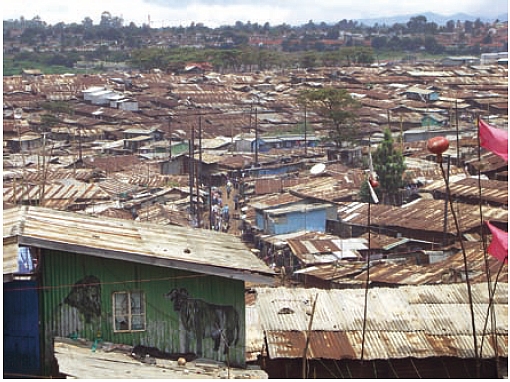
Nairobi, Kenya.
Theme 4: Making Land Markets Work for
All
The land market, more precisely the market in property rights to land, is
not always characterised as a perfect market, where demand and supply are
brought to the most efficient use by the ‘invisible hand’ of the market
mechanism. In many countries certain land rights are not a tradable
commodity, such as customary land rights, allodial lands, religious lands
etc. Even when land rights are fully tradable, the market can still be far
from perfect since access to that sales market may be restricted by
financial, corruption, social or informational reasons.
Many people cannot afford an initial investment in land and there is
growing interest in the functioning of the land rental market. Agricultural
leases and residential rents are easier to pay through regular income
generation, while buying needs a lot of savings or credit facilities. There
are also many social obstacles to land market participation as people might
not be familiar with how the market functions through illiteracy and missing
education, for example. Lack of transparency and information and complex
regulations also creates obstacles. The resulting restrictions mostly
disadvantage of the poor, while being at the advantage of the powerful
elites. This then results in unequal land possession, and at worse, land
grabbing and speculation.
Markets in land rights seldom exist in customary areas, where ownership
of land is vested in the community. Allocation of use rights is de facto and
executed by chiefs, family heads or even the President of the nation.
Scarcity of lands, growing population, and mobility of people lead in many
cases to a demand for individual land rights in these commonly owned lands.
In addition, land claims are increasingly coming from governments or from
project developers and examples show that chiefs of representatives of
collectives do not always understand that they act on behalf of the
community and not for themselves. This erosion of customary areas is
creating the ‘new tragedy of the commons’ symbolising the land grab in these
areas.
Participating in the market requires a certain purchase power. This might
come from savings, but it might take a long time before people are able to
buy property. Land and houses are particularly suitable for serving as
collateral for a loan. However, as the subprime mortgage crisis in the US
revealed, inappropriate loans being provided to high risk groups can lead to
foreclosures and distress sales, leaving poor people landless. The financial
services sector and governments have a major responsibility to set up
regulatory frameworks to reduce the risk of re-occurrence.
Land markets need to be accessible by all and supported by land
information systems that provides transparency in information about
ownership rights and associated transactions and an institutional framework
that delivers simple, affordable and efficient land administration services.
In many countries the World Bank ‘Doing Business Reports’ facilitate the
streamlining of procedures to make transactions simpler, quicker and
cheaper.
However, the concept of property is rapidly evolving from simple
ownership or use, towards complex commodities generated by unbundling
property rights, into separate tradable mineral rights or carbon credits,
for example. This ‘unbundling’ of rights leads to speculative collateralised
debt obligations and, as the recent financial crises has highlighted,
stronger regulation is required across the land and financial services
sectors.
- Formal land markets accelerate wealth generation whilst informal
land markets fail to generate sufficient national wealth to relieve
poverty. Governments therefore need to build land administration systems
to manage the full range of land related commodities [J. Wallace].
- Land and agriculture will increasingly become strategic issues in
the next decade, requiring considerable allocations of attention,
resources and capital. Institutions, such as the World Bank and FAO have
a significant role to play in facilitating partnerships amongst
governments, rural communities and the private sector agri-business
chain. [A. Selby].
- The World Bank ‘Doing Business Reports’ have inspired countries,
such as Burkina Faso, to simplify the number of procedures involved in
land market transactions, opening up the land market to a wider section
of society [ A. Traore].
- Land markets mature and operate to generate significant wealth for
the economy. Land markets migrate through the following five steps as
they mature: land as a societal resource; land rights in terms of secure
tenures; land trading enabling land transfer; land market enabling
dynamic land trading and securitisation; and a complex commodities
market. A key driver in this evolution is the building of mature
cognitive capacity in the public where all stakeholders understand the
land market that is transparent and supports inventiveness and trade in
ideas. [J. Wallace].
- There are two principal types of market imperfections in relation to
the land and property markets: firstly, informational inefficiency where
market participants are not fully informed about market circumstances;
and secondly, allocative inefficiency where a person’s actions have an
impact for others that go beyond legitimate competition. Therefore,
access to common property resources need to be regulated and property
rights provided for one have to be provided for all [R. Grover].
- Low-cost land certification has a significant and positive effect on
the amount of activity in the land rental market. Such reforms generate
reduced transaction costs in the land market. This encourages poor
female households to rent out their land and it becomes easier for
people to access land for renting in [S. Holden].
- Government land acquisition in emerging economies such as China must
be applied through fair and responsible rules and respect the existing
land tenures, especially of the poorest [S. Jin].
The Way Forward
1. Improve primary land delivery to boost land markets
In many countries the trade in land rights between parties (secondary
land market) can only develop after the delivery of land to citizens by the
government (primary land market). When the primary market does not function
well, the secondary market cannot effectively develop causing informal or
illegal land occupation, slums and illegal land markets. This land delivery
is hampered by long lasting procedures, complex regulations, and weak
government structures, for example. Therefore, an effective primary land
market is a prerequisite for any market improvement.
2. Don’t leave social housing to market forces
A consequence of a poorly functioning primary land market is the lack of
social housing supply. When the land market does not work for certain groups
in society, especially the poor, the principles of institutional economics
dictate that governments should assume responsibility for providing social
housing. The allocation of houses in this situation should not be left to
the land market, but to social housing organisations. Governments should
meet their responsibility to
coordinate social housing.
3. Guarantee homeowners funds to protect the poor
When secured credit is used for production purposes, such as buying
livestock, seeds and fertilizers, opportunities for capitalising on property
might exist, on the understanding that the loans can be reasonably paid
back. Some countries offer state guarantees in the form of homeowners
guarantee funds, which aim at protecting the poor against unbearable debts
when, unfortunately, loans cannot be paid back and the property might be
forcedly sold against liquidity value. The development of such homeowners
guarantee funds is highly advisable.
4. Reduce corruption through transparency of markets and incorruptible
land professionals
Corruption investigations have revealed that the land sector is prone to
significant grand and petty corruption. Transparency is the key to fair and
equitable access to the land sales and rental market for all. A high
standard of ethics in the work of land administrators is also a prerequisite
to combat bribing and land grabbing. Therefore, the FIG developed codes of
conduct should be adopted by national and local land professional
associations.
5. Offer fair compensation when the State acquires land and evicts
people
Often the poor suffer from unfair acquisition of land by the State.
Although the justification for land taking might be legitimate, private
right holders should be treated fairly when losing their land rights. In
many circumstances, local government officials play an important role in
offering fair compensation for people to be evicted and land professionals
should develop transparent procedures for land acquisition with fair
compensation mechanisms.
6. Introduce monitoring tools to measure the effective functioning of
the land markets
Many countries are simplifying the number of procedures and reducing the
time and costs involved in transactions in the land market and are realising
economic benefits. Monitoring tools need to be introduced to evaluate the
performance of the functioning of the land market. An example of an existing
tool is the World Bank ‘Doing Business Reports’. Land administration systems
also need to support both traditional and modern communal systems to ensure
that they are protected within the market context.
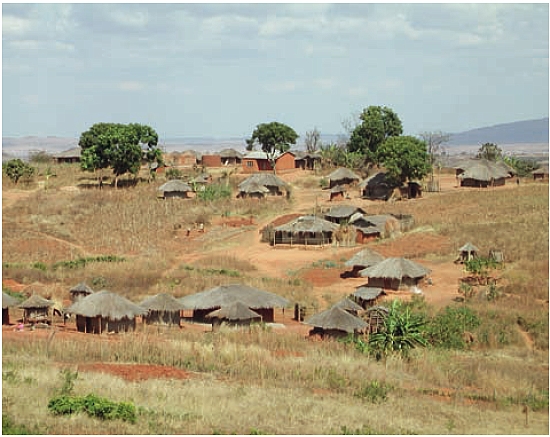
Mozambique.

Mexico.
Theme 5: Improving Access to Land and
Shelter
An increasing number of citizens do not have either permanent or
temporary access to land and adequate shelter. This exclusion is caused, in
many cases, by structural social inequalities, inheritance constraints,
conflicts, non pro-poor and pro-gender land policies and land
administrations systems that are ineffective and expensive for the end user.
Without a range of appropriate interventions being applied within the
broader context of economic growth and poverty reduction policies, social
exclusion and poverty will continue to spiral out of control; already 90% of
all new settlements in sub-Sahara Africa are slums.
Land markets, or formalisation of existing land rights, in spite of their
great flexibility and usefulness to the poor, are not a magical solution for
addressing structural inequalities in countries with highly unequal land
ownership which reduces productivity of land use and restricts development.
To overcome the legacy of such inequality, ways of redistributing assets
such as land reform are still needed. While the post war experiences of
Japan, Korea, and Taiwan, China showed that land reform can improve equity
and economic performance, there are many other cases where land reform could
not be fully implemented or even had negative consequences that illustrate
the difficulties involved. If, within a broader strategy of poverty
reduction, redistributive land reform is found to be more cost-effective in
overcoming structural inequalities than alternatives then it needs to be
aligned with local needs and complemented by access to political support,
managerial ability, technology, credit and markets for the new owners to
become competitive.
Every year a significant number of people are forced to migrate from
their homes due to conflict situations, evictions or natural disasters. In
Iraq, it is estimated that over 5 million Iraqis are currently displaced by
violence and the rebels continue to benefit through the lack of a solution.
In many countries there are no national policies and associated guidelines
that comply with international human rights standards for the eviction of
residents of slums and informal settlements. There are examples of evictions
involving over 50,000 persons in Africa and these slum residents live in
constant fear of eviction. Natural disasters also cause significant
displacement of people; the 2004 tsunami displaced over 1.7 million people.
Effective and early solutions need to be identified and implemented to solve
the housing, land and property issues resulting from these events to enable
social and economic stability.
Only 2% of registered land rights in the developing world are currently
held by women. Many women have very restricted access rights to land and
shelter due to religious, cultural and legal constraints. This situation has
been exacerbated by the AIDS epidemic and requires the design of more gender
responsive land tools.
Highlights of the Conference
- Most violent conflicts are not “caused” by conflicts over land per
se, but almost every major eruption of violent conflict has had a land
dimension. It is essential to look anew at how institutional
arrangements and patterns of political organisation determine when land
becomes an object of violent conflict. If this is not done then
programmes that may be intended to promote participation or good
governance may in fact contribute to aggravating conflict in fragile
states [J. Putzel].
- Several papers reviewed progress of land reform programmes,
especially their impact on poverty, in West Bengal, South Africa and in
the Philippines where the Comprehensive Agrarian Reform Program has been
operational for 20 years [A. Balisacan & F. Bresciani].
- Michael Lipton [lunchtime talk] highlighted the impact on the land
tenure and land reform debate of three great, current adjustments: the
large global GDP setback; rising food and farm energy prices; and the
increasing uncertainty of water availability due in part to climate
change. These adjustments will strengthen the arguments and pressures
for redistributive land reform.
- One of the fundamental ways to strengthen women’s entitlements and
to make their claims over natural and physical assets more enforceable
is through legal reform [R. Meinzen-Dick]. However, legal reforms must
be accompanied by legal-literacy campaigns to ensure that both men and
women are aware of such changes.
The Way Forward
1. Continue effective and sustainable land reform to reduce poverty and
inequality
Land is poor people’s main and usually only productive asset. Around 1.5
billion people today have gained farmland due to land reform, resulting in
many being less poor, or not poor. However, huge land inequalities remain,
or have re-emerged, in many low-income countries; this has been caused by
inheritance rather than efficiency and generated inefficient, low-employment
farm output. In many developing areas with no, minor, ineffective or
incomplete land reform, the poorer half of farming people normally control
below 10% of farmland. The impact on the poor is compounded since not only
does extreme land concentration increase income inequality, but in
developing countries it also reduces farm output and slows growth.
2. Accept that land reform is an on-going process
Land reform interventions are still necessary, in many cases, to reduce
the structural inequalities since market forces will not naturally alleviate
the situation. Land reform is ‘unfinished business’. The new land reform
approaches adopted need to be carefully attuned to their target contexts to
attain their goals of reducing poverty and inequality, ensuring output
efficiency and growth, and achieving sustainability, stability and
legitimacy. Future approaches should be shaped and sensitive to a range of
constraints, including the degree of social and land rights inequalities,
demographic demand, genders rights and roles, resilience of customary
rights, willingness of land owners to cost share, economic affordability of
compensation and the capacity of the population to tolerate and support the
proposed changes.
3. Address land and shelter access issues up front in conflict and
disaster situations
The forced migration of people in conflict situations, or the result of
disasters, causes significant short and long term access issues to land and
shelter. Even where land is at the centre of the conflict, the emergency, or
first phase, is dominated by emergency issues and short-term’ism. It is only
in the second, or reconstruction phase, that housing, land and property
rights are treated within a medium to long term framework. Too often there
is little funding for the second phase by comparison to the first phase.
This means that housing, land and property issues in post conflict
situations are not always addressed adequately. The approach needs to be
improved and longer term measures put in place from the outset and the
delivery of solutions accelerated to support social stability.
4. Identify gender responsive land tools to widen women’s access to land
Women’s lack of access to and control over land is a key factor
contributing to poverty, especially in the increasing feminisation of
agriculture, and needs to be addressed for sustainable poverty reduction.
Although the policy statements of almost all donors active in the land and
natural resources sector emphasise women’s access to land and many countries
also make reference to gender equality in their constitutions, laws relating
to property rights do not often give equal status to women. Women’s access
to and control over resources is shaped by complex systems of common and
civil law as well as customary and religious laws and practices. The
practise and perception of a woman’s position in the household, family and
community still affects to what extent women can exercise their rights. The
challenge now is to translate this political will into action and produce
gender equality across the land sector. We need to identify practical
solutions, particularly at the grassroots level, that support women’s
effective and sustainable access to land and make policy-makers aware of how
this can be achieved.
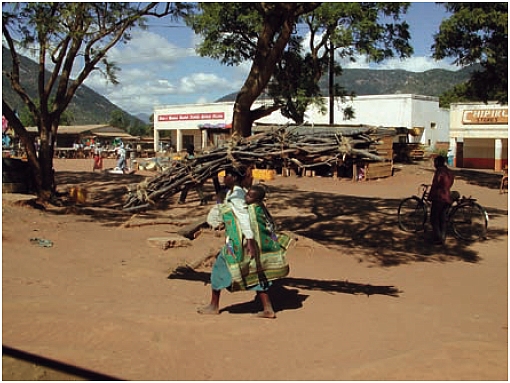
Malawi.
Theme 6: Land Governance for Rapid
Urbanisation
Urbanisation is a major change that is taking place globally. The urban
global tipping point was reached in 2007 when over half of the world’s
population was living in urban areas; around 3.3 billion people. Although
this depends on the definition of ‘urbanisation’, as outlined in the World
Bank’s ‘World Development Report 2009, Reshaping Economic Geography’ (World
Bank, 2009). It is estimated that a further 500 million people will be
urbanised in the next five years and projections indicate that the
percentage of the world’s population urbanised by 2030 will be 60%.
This rush to the cities, caused in part by the attraction of
opportunities for wealth generation, has generated the phenomenon of
’megacities’ that have a population of over 10 million. There are currently
19 megacities and there are expected to be around 27 by 2020. Over half this
growth will be in Asia; the world’s economic geography is now shifting to
Asia.
Megacities exert significant economic, social and political dominance
over their hinterlands. Mega-urban regions are growing, especially in China
(Pearl River Delta) and the US (central east coast) to create clusters of
cities or “system of cities” and while not megacities in the traditional
form of centre and suburbs, they will form “multi-centre megacities”.
This incredibly rapid growth of megacities causes severe ecological,
economical and social problems. It is increasingly difficult to manage this
growth in a sustainable way. It is recognised that over 70% of the growth
currently happens outside of the formal planning process and that 30% of
urban populations in developing countries living in slums or informal
settlements, i.e. where vacant state-owned or private land is occupied
illegally and used for illegal slum housing. In sub-Saharan Africa, 90% of
all new urban settlements are taking the form of slums. These are especially
vulnerable to climate change impacts as they are usually built on hazardous
sites in high-risk locations. Even in developed countries unplanned or
informal urban development is a major issue.
Urbanisation is also having a very significant impact on climate change.
The 20 largest cities consume 80% of the world’s energy use and urban areas
generate 80% of greenhouse gas emissions world-wide. Cities are where
climate change measures will either succeed or fail.
Rapid urbanisation is setting the greatest test for Land Professionals in
the application of land governance to support and achieve the MDGs. The
challenge is to deal with the social, economic and environment consequences
of this development through more effective and comprehensive spatial and
urban planning, resolving issues such as the resulting climate change,
insecurity, energy scarcity, environmental pollution, infrastructure chaos
and extreme poverty.
- The significant rapid urbanisation trend is recognised in the WB’s
‘World Development Report 2009: Reshaping Economic Geography’ that sets
priorities for policies at different stages in urbanisation, essentially
providing the elements of an urbanisation strategy that conforms to the
reality of growth and development. [M. Friere].
- Unplanned urban growth causes significant ecological, economic and
social problems and risks, such as the threat of disasters. The
characteristics of these complex and dynamic systems are not well
understood to allow these risks to be managed and potentially mitigated.
There is a need for a multi-disciplinary perspective to better
understand the process of urbanisation and its governance and to develop
a set of urban indicators based on an integrated approach to physical,
social and environmental aspects of urban growth on one hand and urban
planning and land management on the other, to support good governance
and disaster risk reduction. [T. Kötter].
- Several papers identified unplanned or informal urban development in
developed countries as a major issue; this problem is significant in
more than 20 countries in the ECE region and affects the lives of over
50 million people [C. Potsiou]. In Albania, illegal developments
represent 40% of the built-up area of major cities [D. Dowall].
- The importance of good land governance has long been recognised by
the people of Kenya as a critical issue for sustainable socio-economic
development and an ambitious National Land Policy has recently been
formulated. [R. McLaren].
The Way Forward
1. Adapt land governance measures to support evolving cities for economic
growth
Urbanisation with the continuing concentration of economic activities in
cities is inevitable and generally desirable. Increasing economic density
remains the objective for all areas at different stages (incipient,
intermediate and advanced) of urbanisation. It is essential that appropriate
priorities for policies are set at different stages in urbanisation,
essentially providing the elements of an urbanisation strategy that conforms
to the reality of growth and development. For example, land markets and land
management policies must be sensitive to the urbanisation stage and adapt
over time to allow the use of the same piece of land to change to
accommodate greater value-added activity. This increase in economic density
needs to be balanced with environmental safeguarding through sustainable
development policies and land policies need to manage and connect megacities
and their hinterlands holistically to maximise the significant
economic and social benefits across the region.
2. Develop urban indicators and new information management approaches to
manage complex and dynamic urban environments
Due to the significant dynamics of urbanisation, urban planning and
public infrastructure provision tends to be reactive rather than a guide to
development. Large portions of cities grow outside of the legislative or
development control framework. Lack of information about the informal sector
and its dynamics hinders city officials in formulating and implementing an
urbanisation strategy and increases the ecological, economic and social
problems and risks, such as the threat of disasters. A new set of urban
indicators is needed. This should be supported by a new information
collection / management paradigm with tools, techniques and policies to
monitor and model growth and change across the urban area – all within
shorter timeframes than previously accepted.
3. Develop comprehensive and scalable solutions to the shelter problem
Rapid urbanisation challenges the human right of access to land and
shelter. Slum upgrading approaches need to be more holistic and integrated
into broader slum prevention shelter policies, and appropriate shelter
policies. The aim would be to develop off the shelf solutions that are
replicable and scalable across major urban areas. The issue needs to be
tackled systemically across the city; to include all the cities’ systems
from finance, to land, to shelter, to planning, and so on, at a city wide
scale, within an over-arching shelter policy rather than in a piecemeal
approach. Moving from reactive to preventative approaches is a much needed
paradigm shift that must harness the potential of all actors, including the
grassroots, the private sector (formal and informal) and a strong
decentralised Local Government.

Tokyo, Japan.
7. Appendices
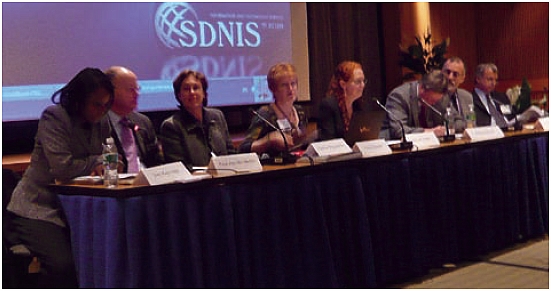
Panel at the Closing Session: Joan Kagwanja, Economic Affairs Officer,
UN-ECA, chair of the closing session (left), Paul van der Molen, the
Netherlands, Clarissa Augustinus, UN-HABITAT, Cheryl Morden, IFAD, Jolyne
Sanjak, MCC, Helge Onsrud, Norway and Alain Durand-Lasserve, France and Paul
Munro-Faure, FAO.

FIG Website:
http://www.fig.net/pub/fig_wb_2009/

World Bank Website (including video recording of a number of sessions) -
click
here.
Copyright © The World Bank and the International Federation of Surveyors
(FIG) 2010.
All rights reserved.
International Federation of Surveyors (FIG)
Kalvebod Brygge 31–33, DK-1780 Copenhagen V
DENMARK
Tel. +45 38 86 10 81
Fax +45 38 86 02 52
E-mail: FIG@FIG.net
www.fig.net
Published in English
Copenhagen, Denmark
ISBN 978-87-90907-72-3
Published by
The International Federation of Surveyors (FIG)
DISCLAIMER
The designations employed and the presentation of material in this
publication do not imply the expression of any opinion whatsoever on the
part of the World Bank concerning the legal status of any county, territory,
city or area or its authorities, or concerning the delimitation of its
frontiers or boundaries regarding its economic system or degree of
development. Excerpts may be reproduced without authorization, on condition
that the source is indicated. Views expressed in this publication do not
necessarily reflect those of the World Bank.
All photos © Stig Enemark
ACKNOWLEDGEMENTS
Editors: Stig Enemark, Robin McLaren and Paul van der Molen
Design and layout: International Federation of Surveyors, FIG
Printer: Oriveden Kirjapaino, Finland
|










































